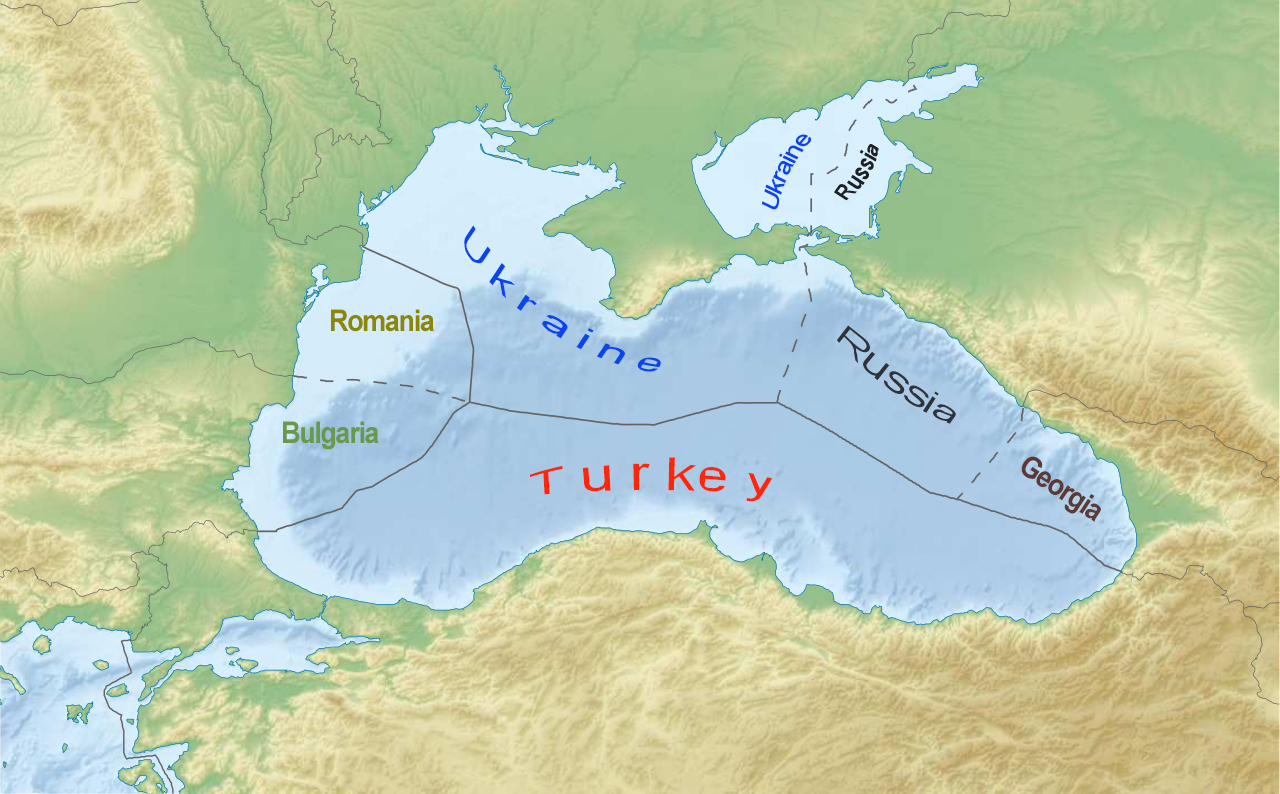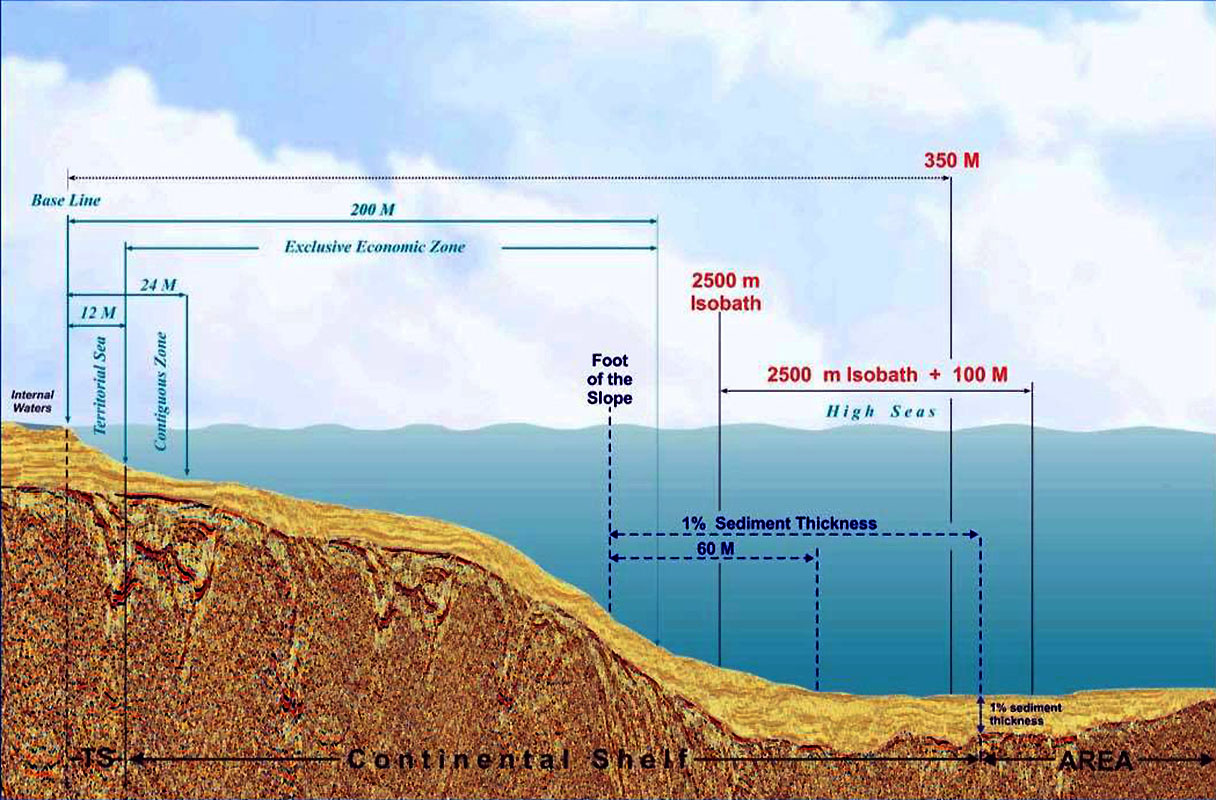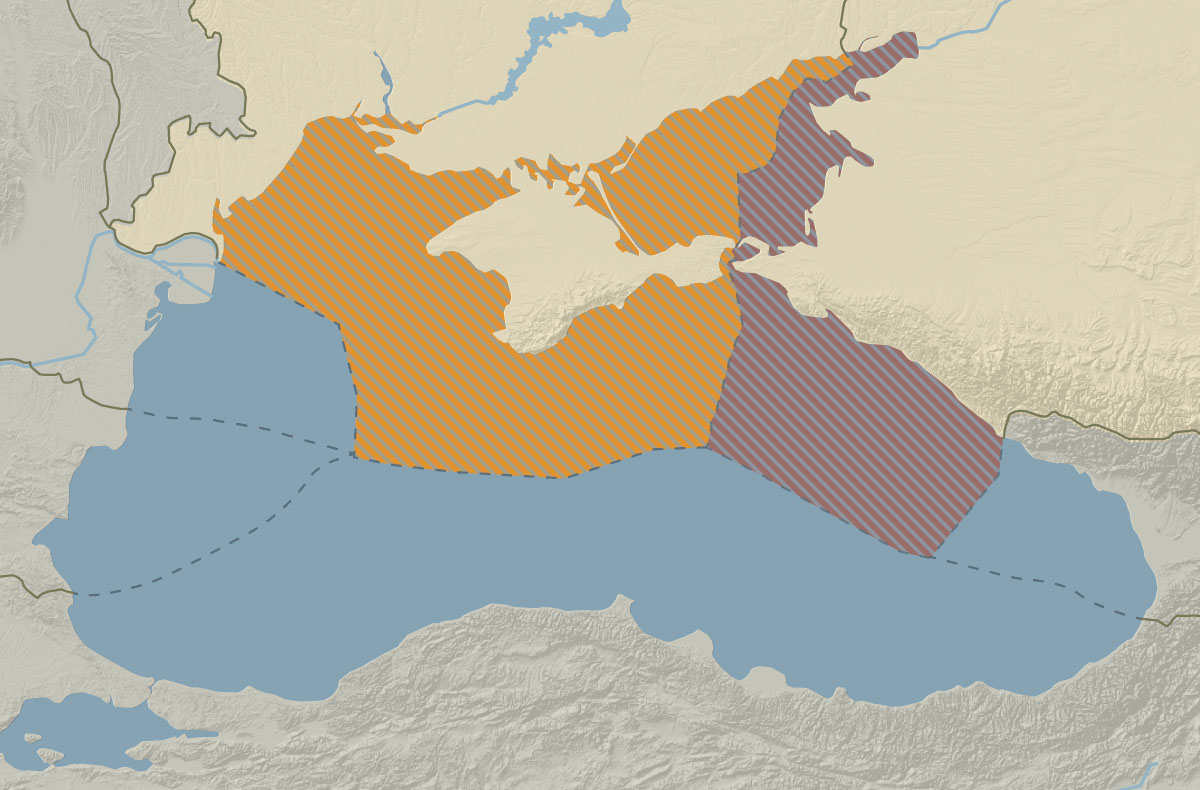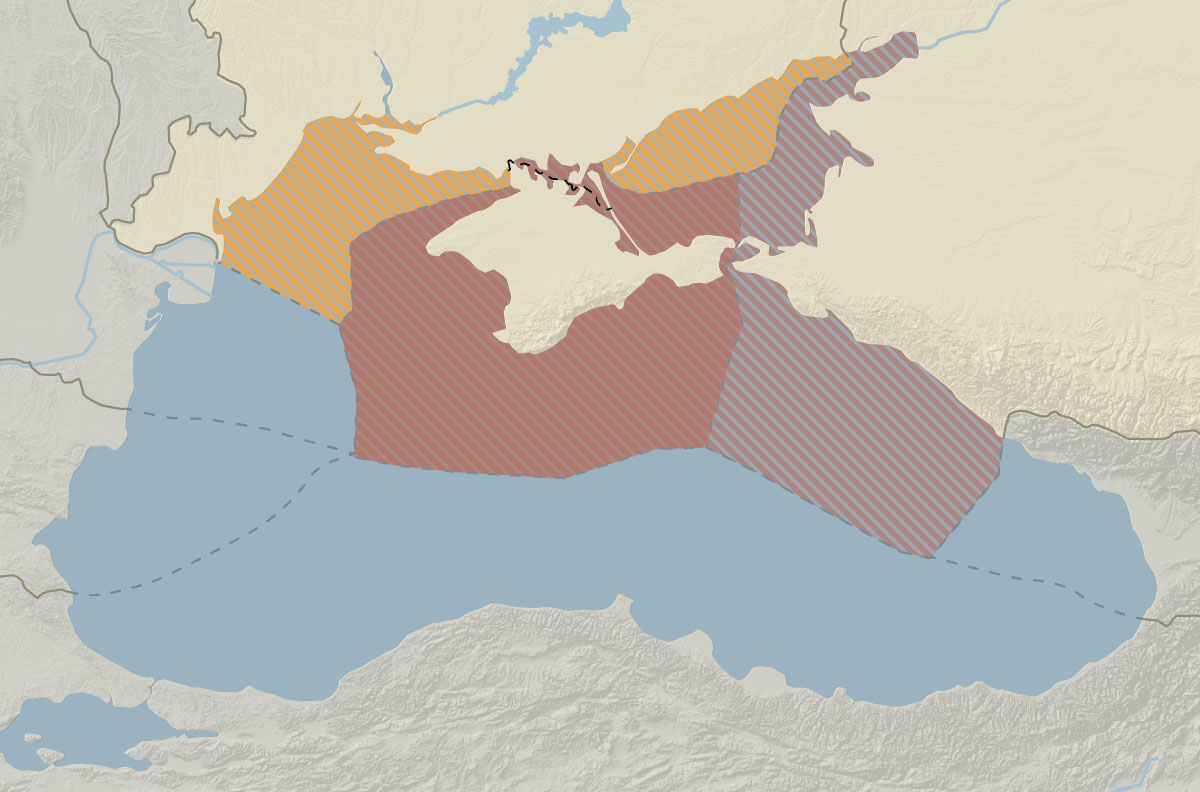Maritime borders as a key element of Ukrainian state building
Bohdan USTYMENKO,
M.J., Attorney at Law
Tetiana USTYMENKO,
S.J.D., professor,
Department of Civil Law and Procedure
National Academy of Internal Affairs
There is no doubt that in terms of natural resources, Ukraine is one of the best endowed countries in Europe.
► To begin with, it has the longest coastline of all the Azov-Black Sea countries — 2759.2 kilometers.
► The Ukrainian Black and Azov Seas shelf contains considerable amounts of already explored mineral deposits, including up to 1583.5 billion cubic meters of natural gas and up to 409.8 million tons of crude oil, which is over 30 percent of Ukraine's total hydrocarbon reserves. So far, though, only 4 percent of those have been extracted, compared to almost 70 percent of the coastal hydrocarbon reserves.
► The five Ukrainian regions that have sea access comprise 27 percent of the country’s total area and account for a considerable part of the national gross domestic product. The majority of their population resides no more than 60 kilometers from the sea and in one way or the other is intertwined with maritime activities.
Considering these factors, the value of sea resources will continue to grow, while the sovereignty and territorial integrity of Ukraine, its economic and energy independence, sustainable development and integration into the Euro-Atlantic political, economic, legal and security space [1] will to a large degree depend on the effectiveness of the state maritime policy (thereinafter — Maritime Doctrine).
According to the Maritime Doctrine, taking into account the country’s geography and resource potential, as well as its current place and role in the global and regional international relations, Ukraine’s assertion as a maritime power is becoming increasingly important.
Maritime Borders
Needless to say, one of the most basic but critical elements of any maritime power is its maritime borders — boundaries that divide the marine spaces (zones) of different states.
The classification offered by Yoshifumi Tanaka, one of the world's leading international maritime law scholars, divides marine spaces into several jurisdiction zones.
According to Tanaka, given the criterion of the national jurisdiction of a coastal state, marine spaces can be therefore divided into two main categories:
- those under national jurisdiction;
- those beyond national jurisdiction.
The first category encompasses internal waters, territorial seas, international straits, archipelagic waters, the contiguous zone, exclusive economic zones and the continental shelf, while the second — the high seas and the Area [2].
For the purposes of this article, we will closely examine only such marine spaces as the territorial sea, contiguous zone, exclusive economic zone and continental shelf in the context of the so-called Constitution of the Oceans — the United Nations Convention Law on the Law of the Sea [3] (hereinafter — the Convention) and Ukraine’s national legislation. Of all the world’s international instruments, the Convention is second in importance only to the UN Charter and is the foundation of the law of the sea.
For a clearer understanding of the difference between the terms maritime border and state border, let’s consider the decision of the United Nations International Court of Justice (hereinafter — the International Court of Justice) in the case of Romania v Ukraine from February 3, 2009 that will be discussed in more detail later.
In the ruling, the International Court of Justice established that the maritime border separating the continental shelf and exclusive economic zones (EEZ) should not be likened to a national border separating the territories of the states, as the first defines the boundaries of marine zones where under international law, coastal states have some sovereign rights for specific purposes, while the latter defines the territorial boundaries of state sovereignty [4].
The maritime border separating the continental shelf and exclusive economic zones (EEZ) should not be likened to a national border separating the territories of the states.
Sea Expanses
Map - Ms. Frida María Armas Pfirter, Professor of Public International Law Buenos Aires University, Austral University
The Territorial Sea
The first marine space (zone) to be considered is the territorial sea.
Article 1 of the Constitution of Ukraine [5] proclaims Ukraine a sovereign independent democratic law-based state;
Article 2 stipulates that the sovereignty of Ukraine extends to its entire territory, which is integral and inviolable within the existing border.
Meanwhile, Article 2 (1) of the Convention establishes that the sovereignty of a coastal state extends beyond its land and internal waters to the adjacent maritime zone, termed the territorial sea.
That sovereignty extends to the airspace above the territorial sea, as well as to its bottom and subsoil.
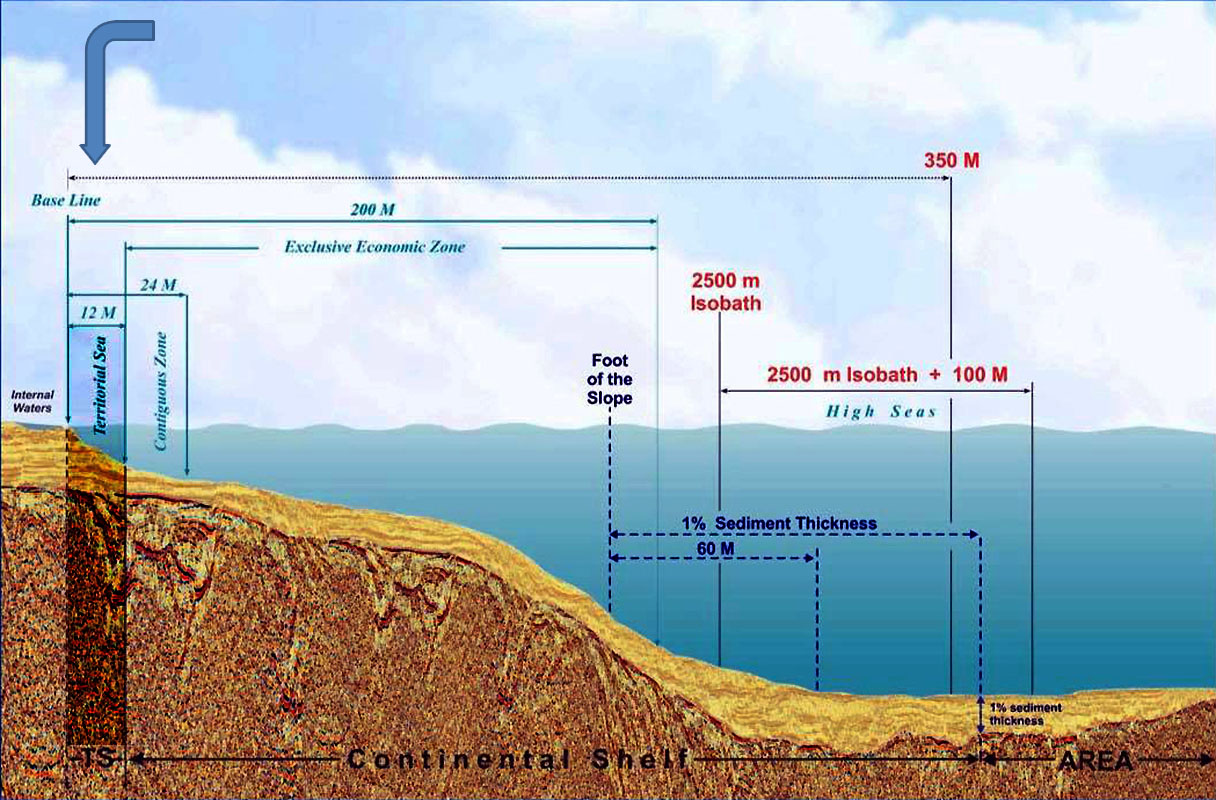 In addition, Article 3 of the Convention states that each state has the right to set the breadth of its territorial sea to a limit not exceeding twelve nautical miles counted from the baselines defined in accordance with the Convention.
In addition, Article 3 of the Convention states that each state has the right to set the breadth of its territorial sea to a limit not exceeding twelve nautical miles counted from the baselines defined in accordance with the Convention.
The outer limit of the territorial sea is the line every point of which is at a distance from the nearest point of the baseline equal to the breadth of the territorial sea (Article 4 of the Convention).
Furthermore, Article 15 of the Convention states that where the coasts of two states are opposite or adjacent to each other, neither of the two states is entitled, failing agreement between them to the contrary, to extend its territorial sea beyond the median line every point of which is equidistant from the nearest points on the baselines from which the breadth of the territorial seas of each of the two states is measured. The above provision does not apply, however, where it is necessary by reason of historic title or other special circumstances to delimit the territorial seas of the two states in a way, which is at variance therewith. However, the above provision shall not apply if, by virtue of historically established legal grounds or other special circumstances, it is necessary to differentiate the territorial seas of the two states in a manner other than that specified in this provision.
The State Border at Sea
At the same time, one must also pay attention to the national legislation concerning the territorial sea of Ukraine. Thus, pursuant to Article 1 of the Law of Ukraine On the State Border of Ukraine [6] (hereinafter — the State Border Law), the state border of Ukraine is a line and a vertical surface that runs along this line that determine the boundaries of the territory of Ukraine on land, water, subsoil and airspace.
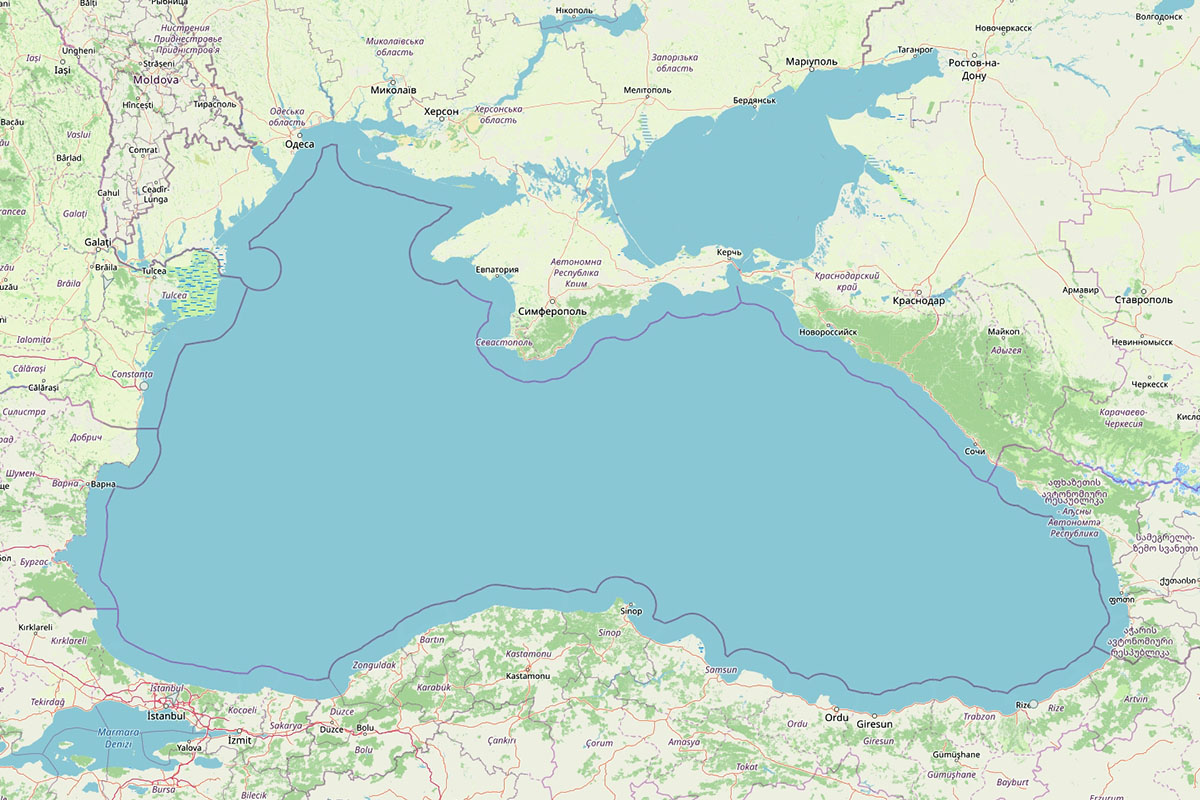 The state border of Ukraine is determined by the Constitution and laws of Ukraine, as well as by the international treaties of Ukraine approved by the Verkhovna Rada of Ukraine (Article 2 of the State Border Law).
The state border of Ukraine is determined by the Constitution and laws of Ukraine, as well as by the international treaties of Ukraine approved by the Verkhovna Rada of Ukraine (Article 2 of the State Border Law).
According to Article 3 of the State Border Law, unless otherwise stipulated by the international treaties of Ukraine, the state border of Ukraine at sea is established on the outer border of the territorial sea of Ukraine.
At the same time, Article 5 of the State Border Law states that the territorial sea of Ukraine includes coastal sea waters with a width of twelve nautical miles distinguished from the largest outflow line both on the mainland and in the islands belonging to Ukraine or from direct baselines connecting the corresponding points.
In some cases, Ukraine’s international treaties may establish other breadth of the territorial sea of Ukraine, while in the absence of such treaties, it is set in accordance with the generally recognized principles and rules of international law.
Joint Area
In regard to the marine space adjacent to the territorial sea and termed contiguous zone,
Article 33 of the Convention states that there the coastal state may exercise control necessary to:
1) prevent violations of the customs, fiscal, immigration or sanitary laws and regulations within its territorial sea area;
2) prosecute for breach of the above laws and regulations committed within its territorial sea area.
The contiguous zone may not extend beyond twenty-four nautical miles from the baselines from which the breadth of the territorial sea is measured (Article 33, paragraph 2, of the Convention).
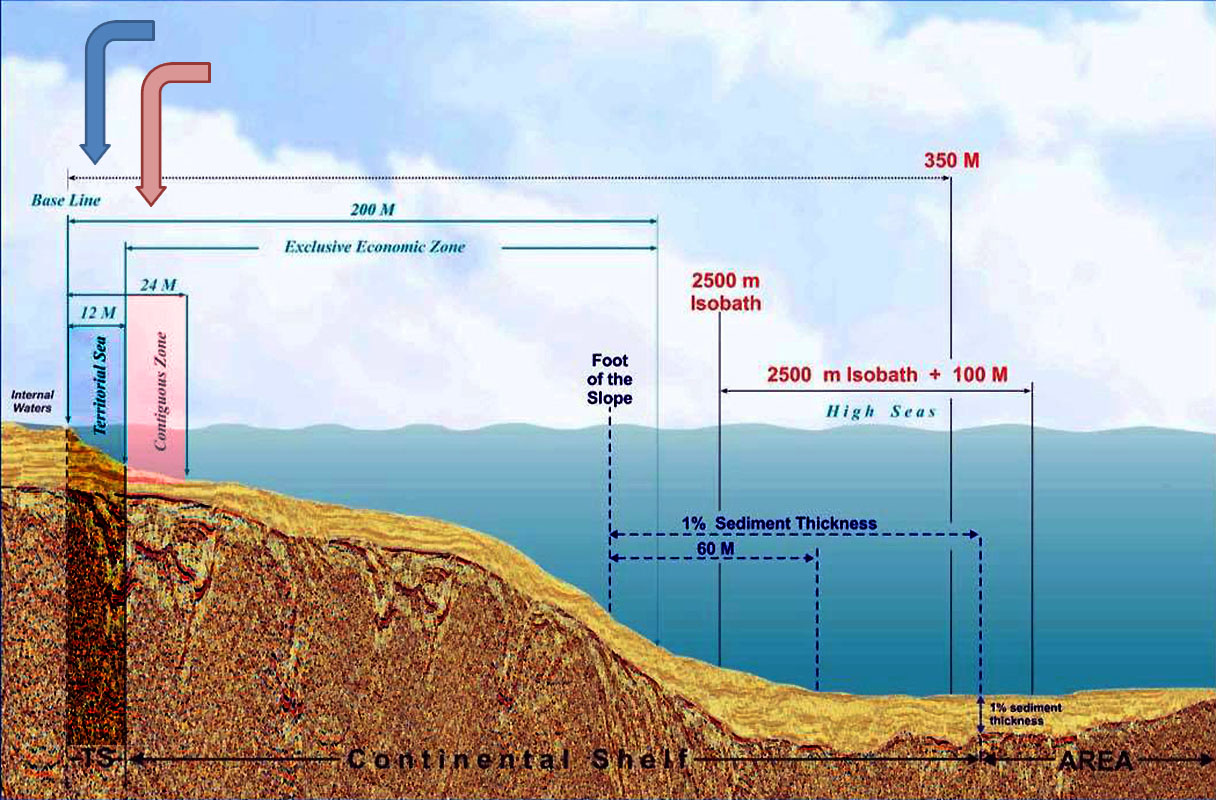 Also, Ukraine has a separate law that establishes the status and the legal regime of the contiguous zone of Ukraine. Thus, according to Article 1 of the Law of Ukraine On the Contiguous Zone of Ukraine [7], the contiguous zone of Ukraine (hereinafter — the contiguous zone) is a sea belt whose outer border is at a distance of no more than 24 nautical miles measured from the same baselines, as the width of the territorial sea of Ukraine.
Also, Ukraine has a separate law that establishes the status and the legal regime of the contiguous zone of Ukraine. Thus, according to Article 1 of the Law of Ukraine On the Contiguous Zone of Ukraine [7], the contiguous zone of Ukraine (hereinafter — the contiguous zone) is a sea belt whose outer border is at a distance of no more than 24 nautical miles measured from the same baselines, as the width of the territorial sea of Ukraine.
Delimitation of the contiguous zone between Ukraine and the states whose coasts are opposite or adjacent to the coast of Ukraine is carried out in accordance with the international treaties of Ukraine (Article 2 of the Law of Ukraine On the Contiguous Zone of Ukraine).
In accordance with Article 3 of the Law of Ukraine On the Contiguous Zone of Ukraine, in its contiguous zone, Ukraine shall exercise the control necessary to:
1) prevent violations of the customs, fiscal (tax), immigration (migration), and sanitary legislation of Ukraine within the territory of Ukraine, including its internal waters or territorial sea;
2) prosecute for violations of the Ukrainian legislation referred to in paragraph 1, committed within the territory of Ukraine, including its internal waters or territorial sea.
In order to prevent the aforementioned violations of the Ukrainian legislation or hold liable for the violations, the authorized body ensuring the inviolability of the state border and protecting Ukraine’s sovereign rights in its contiguous and exclusive (marine) economic zones (hereinafter — the authorized body) may:
1) stop the ships;
2) inspect the ships and
3) detain or arrest the ships and/or their crew, with the exception of warships and other government vessels used for non-commercial purposes.
If a vessel violates the laws of Ukraine and attempts escape, the competent authority has the right to hot pursuit in order to detain and prosecute the infringer under the Convention. The right to pursuit ceases at the moment when the vessel enters the territorial sea of its flag state or any third state.
Exclusive (Maritime) Economic Zone
Special attention should be also paid to the status and legal regime of marine space termed the exclusive economic zone.
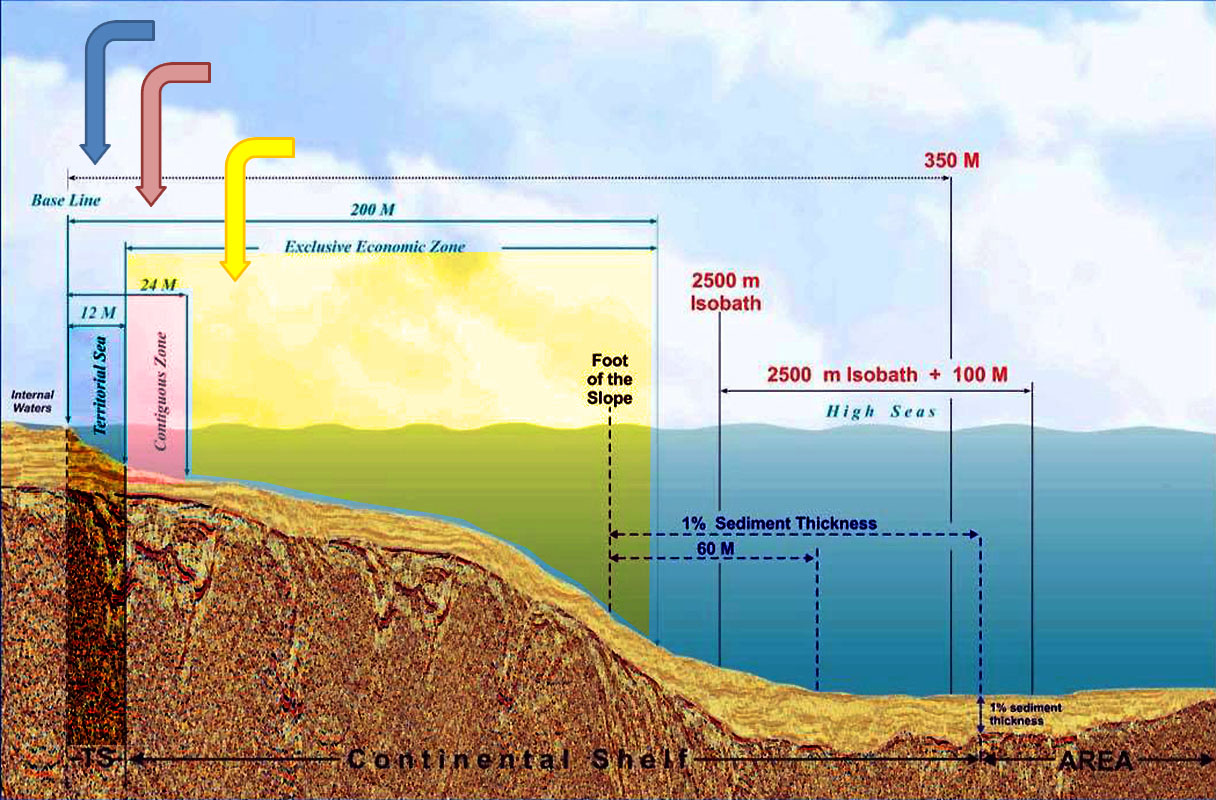 Thus, Article 55 of the Convention establishes that the exclusive economic zone is an area situated outside the territorial sea and adjacent to it that is subject to a special legal regime under which the rights and jurisdiction of a coastal state and the rights and freedoms of other states are governed by the relevant provisions of the Convention.
Thus, Article 55 of the Convention establishes that the exclusive economic zone is an area situated outside the territorial sea and adjacent to it that is subject to a special legal regime under which the rights and jurisdiction of a coastal state and the rights and freedoms of other states are governed by the relevant provisions of the Convention.
The width of the exclusive economic zone must not exceed 200 nautical miles measured from the same baselines as the territorial sea of Ukraine (Article 57 of the Convention).
Pursuant to Article 74 of the Convention, the delimitation of the exclusive economic zone between states with opposite or adjacent coasts is effected by concluding agreements on the basis of international law, as indicated in Article 38 of the Statute of the International Court of Justice, in order to achieve an equitable solution. If no agreement has been reached within a reasonable period, the states concerned should resort to the procedures provided for in the Convention.
At the same time, on the basis of the Convention, Ukraine has adopted its own special legislation on the exclusive (marine) economic zone. According to Article 2 of the Law of Ukraine On the Exclusive (Marine) Economic Zone of Ukraine [8], the marine areas externally adjacent to the territorial sea of Ukraine, including the areas around the islands belonging to it, constitute the exclusive (marine) economic zone of Ukraine. The width of the exclusive (marine) economic zone is no more than 200 nautical miles measured from the same baselines as the territorial sea of Ukraine.
Article 3 of the Law of Ukraine On the Exclusive (Marine) Economic Zone of Ukraine stipulates that delimitation of the exclusive (marine) economic zone shall be carried out in accordance with the legislation of Ukraine by concluding agreements with the states whose coasts are opposite or adjacent to the coast of Ukraine on the basis of principles and criteria generally accepted in international law in order to achieve an equitable solution.
Per the provisions of Article 4 of the above Law, in its exclusive (marine) economic zone Ukraine has:
· sovereign rights to explore, develop and conserve the living and non-living natural resources in the waters above seabed, the seabed and subsoil and manage those resources, as well as undertake other economic exploration and development activities in the designated area, including the production of energy through the use of water, currents and wind
· the jurisdiction provided for by the relevant provisions of this Law and the rules of international law for the creation and use of artificial islands, installations and structures, marine scientific research and the protection and conservation of the marine environment
·other rights provided by the Law, other legislative acts of Ukraine and generally recognized norms of international law.
The sovereign rights and jurisdiction of Ukraine regarding the seabed of the exclusive (marine) economic zone and its subsoil are implemented in accordance with the legislation of Ukraine on the continental shelf and the Subsoil Code of Ukraine.
The provisions on the exclusive (marine) economic zone are also addressed in Article 411 of the Economic Code of Ukraine [9] (hereinafter — the EC). The EC stipulates that in order to ensure the sovereign rights of Ukraine for exploration, exploitation, conservation and management of living resources in the exclusive (marine) economic zone, the state undertakes measures — including inspection, arrest and judicial review — to ensure compliance of business entities with the Ukrainian legislation.
The state in the exclusive (marine) economic zone of Ukraine has the exclusive right to facilitate, permit and regulate the construction, operation and use of artificial islands, installations and structures for marine scientific research, exploration and development of natural resources and other economic purposes per Ukrainian legislation.
Continental Shelf
Another marine space whose status and legal regime needs to be reviewed is the continental shelf.
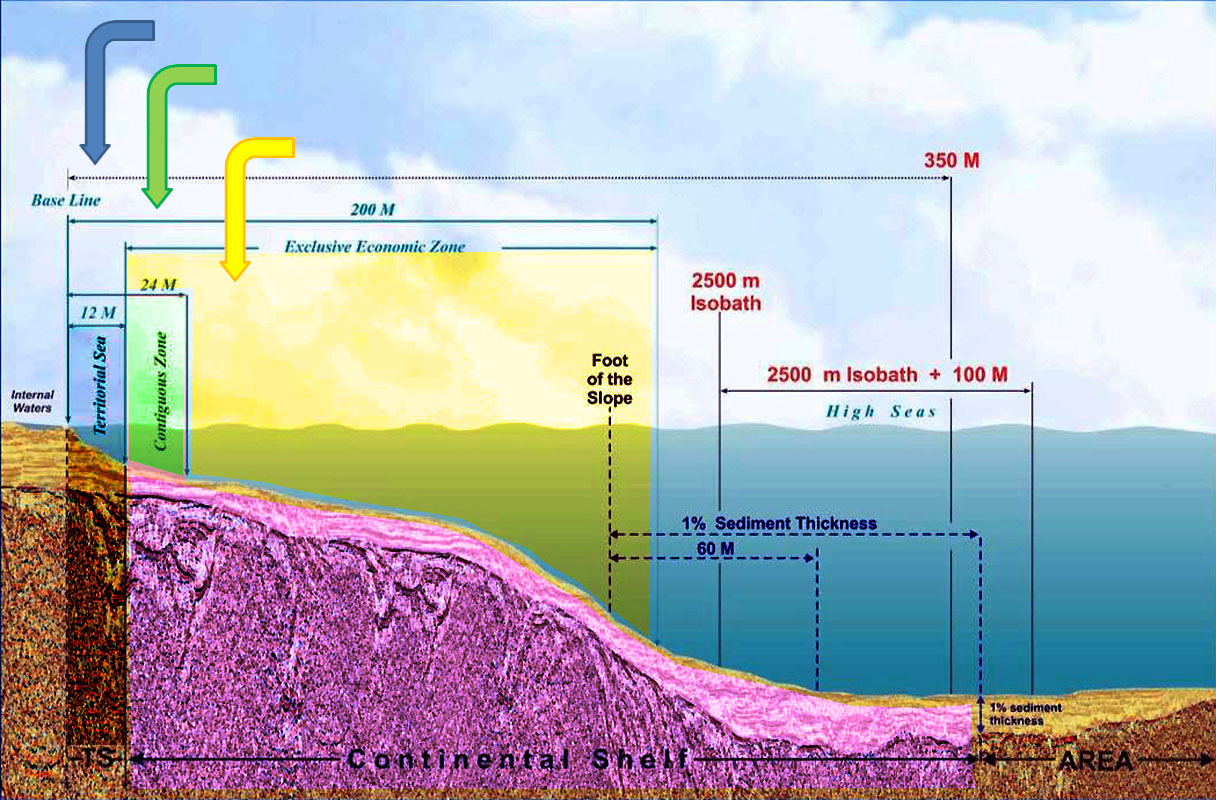 Article 76 of the Convention stipulates that the continental shelf of a coastal state includes the seabed and subsoil of underwater areas extending beyond its territorial sea throughout the natural prolongation of its land territory to the outer edge of the continental margin, or to a distance of 200 nautical miles from the baselines from which the breadth of the territorial sea is measured where the outer edge of the continental margin does not extend up to that distance.
Article 76 of the Convention stipulates that the continental shelf of a coastal state includes the seabed and subsoil of underwater areas extending beyond its territorial sea throughout the natural prolongation of its land territory to the outer edge of the continental margin, or to a distance of 200 nautical miles from the baselines from which the breadth of the territorial sea is measured where the outer edge of the continental margin does not extend up to that distance.
The fixed points comprising the line of the outer limits of the continental shelf on the seabed must not exceed either 350 nautical miles from the baselines from which the breadth of the territorial sea is measured or 100 nautical miles from the 2,500 meter isobath, which is a line connecting the depth of 2,500 meters.
According to Article 77 of the Convention, the coastal State exercises sovereign rights over the continental shelf for the purpose of its exploration and development of its natural resources. These rights are exclusive in the sense that if the coastal state does not explore the continental shelf or exploit its natural resources, no one may undertake these activities without the express consent of the coastal state.
The continental shelf's natural resources include the mineral and other non-living resources of the seabed and subsoil together with living organisms belonging to sedentary species, that is to say, organisms that, at the harvestable stage, either are immobile on or under the seabed or are unable to move except in constant physical contact with the seabed or the subsoil.
Pursuant to Article 83 of the Convention, the delimitation of the continental shelf between states with opposite or adjacent coasts is effected by agreements concluded on the basis of international law, as indicated in Article 38 of the Statute of the International Court of Justice, in order to achieve an equitable solution. If no agreement has been reached within a reasonable period, the states concerned should resort to the procedures provided for in the Convention.
* * *
We have covered the most important terms and definitions that would allow us to move on to an overview of the current situation as a result of Russia's occupation of the Crimean peninsula in the following articles.
To illustrate the problem, we present only 2 maps:
The exclusive maritime economic zone of Ukraine before the occupation of the Crimean peninsula:
The exclusive maritime economic zone of Ukraine after the occupation of the Crimean peninsula (part of the occupied EMEZ of Ukraine marked):
Source: Lamont-Doherty Earth Observatory of Columbia University, https://www.nytimes.com/2014/05/18/world/europe/in-taking-crimea-putin-gains-a-sea-of-fuel-reserves.html
To be continued...
* * *
References:
1. Pro zatverdzhennya Morskoi doktryny Ukrainy na period do 2035 roku: Postanova Cabinetu Ministriv Ukrainy vid 07.10.2009, № 1307. (On Approving the Maritime Doctrine of Ukraine for the Period up to 2035: Resolution of the Cabinet of Ministers of Ukraine from October 7, 2009, #1307). URL: https://zakon.rada.gov.ua/laws/show/1307-2009-%D0%BF.
2. Yoshifumi Tanaka, The International Law of the Sea, third edition (Cambridge University Press, 2019). – p. 554.
3. Konventsiia Organizatsii Ob`yednannykh Natsii z morskogo prava vid 10.12.1982, ratyfikovana Zakonom Ukrainy «Pro ratyfikatsiyu Konventsiia Organizatsii Ob`yednannykh Natsii z morskogo prava 1982 roku ta Ugody pro implementatsiyu Chastyny XI Konventsii Organizatsii Ob`yednannykh Natsii z morskogo prava 1982 roku» № 728-XIV vid 03.06.1999 // Vidomosti Verkhovnoii Rady Ukrainy. – 1999, № 31, stattya 254 (United Nations Convention on the Law of the Sea of December 10, 1982, ratified by the Law of Ukraine "On Ratification of the United Nations Convention on the Law of the Sea of 1982 and the Implementation Agreement for Part XI of the United Nations Convention on the Law of the Sea 1982" # 728-XIV from June 3, 1999, Bulletin of the Verkhovna Rada of Ukraine, 1999, #31, article 254).
4. Кratkoye izlozheniye resheniy, konsultativnykh zaklyuchenii i postanovleniy Mezhdunarodnogo Suda 2008-2012 (Summary of Judgments, Advisory Opinions and Orders of the International Court of Justice 2008-2012), UN, New York, 2014. URL: https://www.icj-cij.org/files/summaries/summaries-2008-2012-ru.pdf - p. 85.
5. Constitutsiya Ukrainy vid 28.06.1996 // Vidomosti Verkhovnoii Rady Ukrainy.- 1996, № 30, stattya 141. (The Constitution of Ukraine of June 28, 1996, Bulletin of the Verkhovna Rada of Ukraine, 1996, #30, article 141).
6. Pro derzhavnyi kordon Ukrainy: Zakon Ukrainy vid 04.11.1991 // Vidomosti Verkhovnoii Rady Ukrainy. - 1992, № 2, stattya 5 (On the State Border of Ukraine: Law of Ukraine of November 4, 1991, Bulletin of the Verkhovna Rada of Ukraine, 1992, #2, Article 5).
7. Pro pryleglu zonu Ukrainy: Zakon Ukrainy vid 06.12.2018 р. / Ofitsiinyi visnyk Ukrainy.- 2019, № 4, stor. 11, stattya 105 (On the Contiguous Zone of Ukraine: Law of Ukraine from December 6, 2018, Official Bulletin of Ukraine, 2019, # 4, p. 11, Article 105).
8. Pro vyklyuchnu morsku (economichnu) zonu: Zakon Ukrainy vid 16.05.1995 р. // Vidomosti Verkhovnoii Rady Ukrainy. - 1995, № 21, stattya 152 (On the Exclusive (Marine) Economic Zone: Law of Ukraine of May 16, 1995, Bulletin of the Verkhovna Rada of Ukraine, 1995, #21, Article 152).
9. Gospodarkyi kodeks Ukrainy від 16.01.2003 // Ofitsiinyi visnyk Ukrainy.- 2003, № 11, stor. 303, stattya 462 (The Economic Code of Ukraine of January 16, 2003 , Official Bulletin of Ukraine, 2003, #11, p. 303, Article 462).
10. Ugoda mizh Uryadom Ukrainy і Uryadom Respubliky Turechchina pro kordon economichnykh (morskykh) zon Ukrainy і Respubliky Turechchina vid 30.05.1994 (Agreement between the Government of Ukraine and the Government of the Republic of Turkey on the Border of Economic (Marine) Zones of Ukraine and the Republic of Turkey of 30 May 1994). URL: https://zakon.rada.gov.ua/laws/show/792_008.
11. Dogovir pro vidnosyny dobrosusidstva і spivrobitnytstva mizh Ukrainoyu ta Rumuniyeyu vid 02.06.1997, ratyfikovanyi 17.07.1997 (Agreement on Good Neighborly Relations and Cooperation betwen Ukraine and Romania of June 2, 1997, ratified on July 17, 1997). URL: https://zakon.rada.gov.ua/laws/show/642_003 .
12. Кratkoye izlozheniye resheniy, konsultativnykh zaklyuchenii i postanovleniy Mezhdunarodnogo Suda 2008-2012 (Summary of Judgments, Advisory Opinions and Orders of the International Court of Justice 2008-2012), UN, New York, 2014. URL: https://www.icj- cij.org/files/summaries/summaries-2008-2012-ru.pdf. – p. 69.
13. Dogovir mizh Ukrainoyu ta Rosiiskoyu Federatsiyeyu pro spivrobitnytstvo u vykorystanni Azovskogo morya і Kerchenskoi protoky vid 24.12.2003 (Agreement Between Ukraine and the Russian Federation on Cooperation in the Use of the Sea of Azov and the Kerch Strait of December 24, 2003). URL: https://zakon.rada.gov.ua/laws/show/643_205.
14. Rozporyadzhennya Prezidenta Ukrainy «Pro vnesennya zmin do Rozporyadzhennya Prezidenta Ukrainy vid 6 zhovntya 1998 roku № 515 «Pro okhoronu derzhavnogo kordonu Ukrainy v Azovskomu ta Chormonu moryakh і Kerchenskyi prototsi ta zabespechennya prav Ukrainy u vyklyuchniy (morskiy) economichniy zoni ta contynentalnomu shelfi u pivnichno-skhidniy chastyni Chornogo morya» vid 6 serpnya 1999 roku № 187/99-rp (Decree of the President of Ukraine On Amendments to the President of Ukraine’s Decree #515 of October 6, 1998 «On Protection of the State Border of Ukraine in the Azov and Black Seas and the Kerch Strait and the Protection of Rights of Ukraine in the Exclusive (Marine) Economic Zone and Continental Shelf in the North-East part of the Black Sea» from August 6, 1999, #187/99-rp). URL: https://zakon.rada.gov.ua/laws/show/187/99-%D1%80%D0%BF.
The article addresses the types of modern Ukraine’s maritime areas in light of the norms of international maritime law and national legislation provisions, and analyzes international documents that establish maritime borders between Ukraine and other coastal states.
The authors propose that Ukraine: 1) promptly commences the compulsory conciliation on Ukraine-Russia maritime border delimitation per Article 298(1)(a)(i) and Annex V, section 2 of the United Nations Convention on the Law of the Sea and 2) adopts the laws on the internal waters and the territorial sea of Ukraine.
* * *
 This publication has been produced with the support of the European Endowment for Democracy (EED). Its contents do not necessarily reflect the official opinion of EED. Responsibility for the information and views expressed in this publication lies entirely with the authors.
This publication has been produced with the support of the European Endowment for Democracy (EED). Its contents do not necessarily reflect the official opinion of EED. Responsibility for the information and views expressed in this publication lies entirely with the authors.
